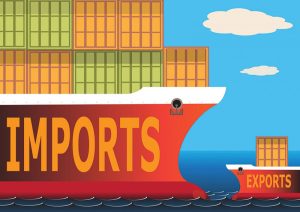12 Nov Current Account Deficit to hit 1.4% of GDP: Barclays (GS 3, Economics, The Hindu, Indian Express)
News/Context: British brokerage Barclays has reported that fragile recovery of the Indian economy could be more pressurized by widening current account deficit of India which is driven by surge in the commodity price led by crude oil. The Brokerage has revised current account deficit forecast of India to 245 billion dollars by the month of March, which comes as 1.4 % of GDP.
As per the brokerage report, the continuous jump in the trade deficit since July, is the main cause of worry. The report said the average monthly trade deficit has jumped to 16.8 billion dollar in July to October, which was 12 billion dollar till June. The month of September got 22.6 billion dollar trade deficit which is the highest ever on record.
The report has increased the current account deficit forecast to 45 billion dollar for the financial year 2021-22 (FY22), up from 35 billion dollar earlier, But has indicated that a large balance of payment surplus remains on track. It has been estimated that the trade deficit will be widened by 12 billion dollar or 35 base points (0.35%) of GDP with every 10 dollar per barrel rise in global crude prices, as around 85% of the oil demand is his met through imports
The Brokerage has noted down that there will be no risk to macroeconomic stability given the record high foreign Reserves, and thus ruled out any alarming situation at at current point of time.
It can be understood from the data that the higher oil prices has mainly fuelled the larger trade deficits. During the past three months the monthly oil trade deficit has risen to 8.5 billion dollar from an average of 5.2 billion dollar in the first half of the current financial year, as per the report.
Because of the fact that the economy is recovering fast post pandemic, oil import’s volume has significantly jumped over the past few months but still it is below pandemic levels, as per the report. Also the pace of the oil demand is most likely to accelerate in the upcoming months.
As per the report is expected that crude import will remain elevated, which will be resulted into relatively high volume import in the coming months.
Increasing gold import is also another factor driving down the foreign exchange and pressurizing the current account deficit, which have been witnessed on a faster clip for months.
The world gold Council is expecting Gold demands this year can surpass the 2020 levels, looking into the fact that the ongoing festive seasons and recovering domestic demand are boosting the imports of yellow metal. And it expects that due to rising wealth effects and incomes the demand for the gold will be remaining high.
On the positive side of the current account, the monthly services surplus ( services export minus services import) is getting better. In 2019 the average monthly service surplus was 6.6 billion dollar, which got better to 7 billion dollar in 2020. It further went up to 8 billion dollar in the first nine months of 2021.
The report is expecting that the country can generate a yearly service surplus of nearly 100 billion dollar for the first time as it is expecting the resumption of international travel will be having a limited impact on the services balance.
Let’s understand the dynamics behind Current Account Defict: When there is a rise in the Current Account Deficit (CAD), it means the dollar is moving out of the country or demand for the Dollar is increasing. The price of the Dollar will go up against Rupee. It is termed as the Devaluation of Rupee, the domestic currency. The devaluation of the rupee will make export cheaper and import costly. There would be export competitiveness but to increase the export you need better quality products along with increased production capacity. Devaluation generally favors more to a country like China and less to a country like India.
In the case of our country, after devaluation, the gain of getting export competitiveness is less than the loss due to costly import. Among import items the crude oil is major. Crude oil gets costly after devaluation. Sectors including aviation, lubricants, refining and tyres are sensitive to oil price movement. As a rise in crude oil prices impacts input raw material cost, profitability comes under pressure, thereby hurting almost every sector and we witness a general price rise which is nothing but inflation. Hence in our country, devaluation leads to inflation. During the period of high inflation, people used to buy gold as gold gives better real returns compare to keeping the money in the banks. (Purchasing gold is an unproductive investment). This will put pressure on gold and gold import will rise. Dollars will move out and will stretch the current account deficit further. The economy could be trapped in this kind of vicious cycle. People must have a wide range of investment options. In response to this vicious cycle, RBI issues Inflation-indexed Bonds and the Government regulates the import of gold.
In recent days the increase in the prices of coal and crude oil poses the same challenges of the vicious cycle as mentioned above.
Md Layeeque Azam, Economics Faculty
Plutus IAS Current Affairs Team Member




No Comments